#nez perce
Text

Skitswish (Coeur d'Alene) and Nimíipuu woman, United States of America, Antoinette Peters, by Tara Kerzhner
#skitswish#coeur d'alene#nimiipuu#nez perce#america#north america#united states of america#folk clothing#traditional clothing#traditional fashion#cultural clothing
722 notes
·
View notes
Photo



Dress
Niimíipuu (Nez Perce) People
c.1920
National Museum of the American Indian (Catalog Number: 22/581)
Learn More about the Niimíipuu (Nez Perce) People on their website: https://nezperce.org/
#dress#fashion history#niimiipuu#nez perce#1920s#indigenous americans#native american#20th century#leather#beading#1920#traditional clothing#traditional fashion#national museum of the american indian
934 notes
·
View notes
Text

#Timucua#indigenous#ndn#landback#n8v#salish#penddoreille#kalispel#kalispell#Chippewa#ojibwe#saulteaux#metis#red river metis#nez perce#interior salish#cree#inuit#apache#maya#choctaw#lumbee#sioux#dakota#lakota#blackfoot
52 notes
·
View notes
Text
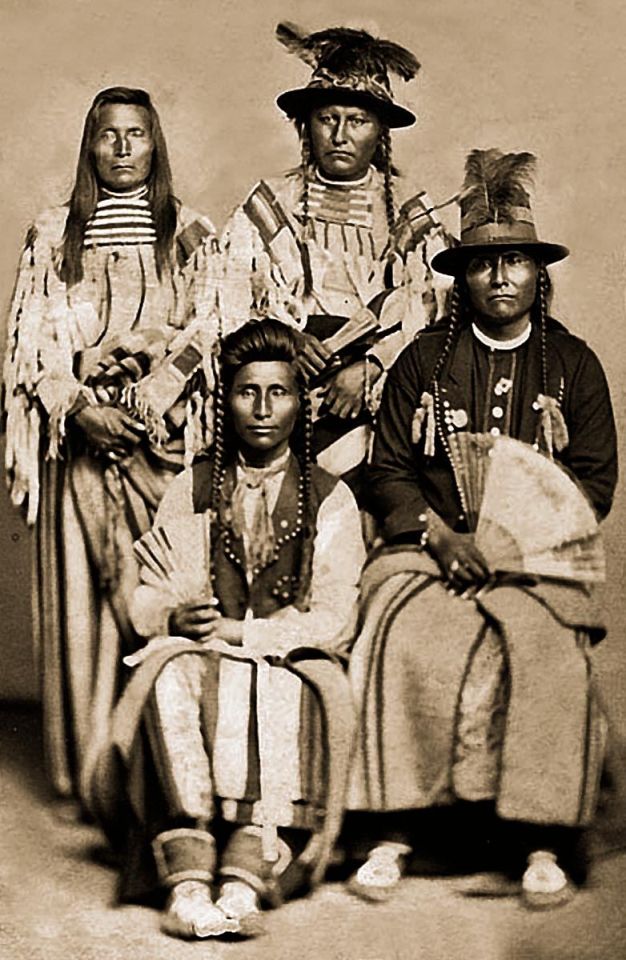
Standing L-R Rabbit Skin Leggings, Yellow Bird Sitting L-R Charley Moses, Chief Joseph - Nez Perce - 1877 2
#indigenous#chief joseph#nez perce#native american#nimiipuu#indigenous americans#20th century#Colville#Nespelem#history#photographs#historical photos#Hin-mah-too-yah-lat-kekt
27 notes
·
View notes
Text
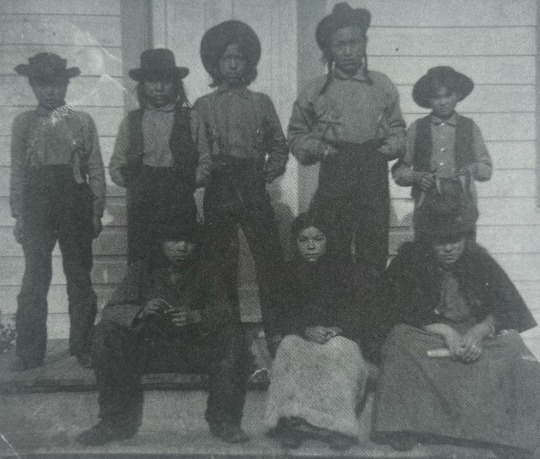
Plateau kids before church c.1910
#ndn#indigenous#indigenous history#native american#ndn country#yakima#Shoshone#nez perce#reservation#Oregon#Washington#Idaho
41 notes
·
View notes
Text
“Western history does not show us any evolution toward greater spirit, greater meaning, greater culture. The Western Roman-Christian contribution to the world, when we look at it, has been almost entirely in the area of technology, and of analytical intellect; combined with a notorious spiritual and cultural alienation, and perhaps the loneliest individuals the planet has ever seen. What there still is of spirit, of poetry, of coherent meaning, of symbolic truth in the world did not come from "us." It was there at the beginning, among our Stone Age ancestors. Their vision, their cosmology, their intuited truth and sacred analogies run like bright red threads through the tapestry of Western history; whatever is still alive and vibrating in patriarchal religions, especially Christianity, when traced to its source, is found to be one of these bloody living fibers retained (stolen) from the original Paleolithic cosmology, woven by these Ice Age people out of their primal pagan experience of the Great Mother and her magic world.
What has followed them, in the mythic, religious, spiritual, and psychic realms at least, has been no great advance, but a devolution—a corruption, a narrowing and hardening, an atrophy of vision and heart. Our Stone Age ancestors would have no trouble understanding the words of Smohalla, a Nez Perce who sang the primal truth to the "white man's world" of nineteenth-century business- and resource-development-oriented America:
My young men shall never work. Men who work cannot dream and wisdom comes in dreams. You ask me to plough the ground. Shall I take a knife and tear my mother's breast? Then when I die She will not take me to her bosom to rest. You ask me to dig for stone. Shall I dig under Her skin for bones? Then when I die I cannot enter Her body and be born again. You ask me to cut grass and make hay and sell it and be rich like the white man. But how can I cut off my mother's hair? It is bad law and my people cannot obey it. I want my people to stay with me here. All the dead humans will come to life again. We must wait here in the house of our ancestors and be ready to meet in the body of our mother.”
-Monica Sjöö and Barbara Mor. The Great Cosmic Mother: Rediscovering The Religion of the Earth.
#monica sjöö#barbara mor#western civilization#nez perce#stone age#ice age#paleolithic#feminist spirituality#anti christianity
21 notes
·
View notes
Text
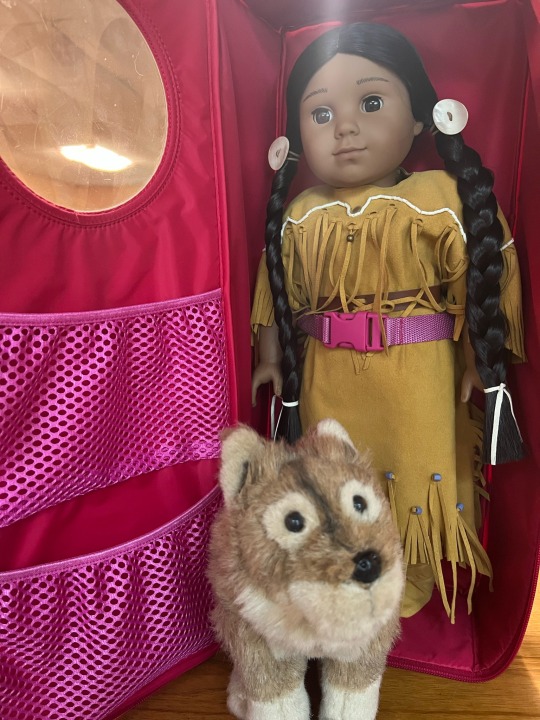
Look who I snuck into school with me today. One of my students is reading her series so I just had to.
17 notes
·
View notes
Text
Kaya’aton’my’s Series – Nimiipuu Names

While we have a pretty good shot at guessing Two Hawks’s name, I wanted to make a list of the most likely names for the Nimiipuu/Nez Perce characters in Kaya’s series, as a few Nimiipuutímt dictionaries are available.
Even as a kid, I always wondered what everyone’s name was in their actual language, as all but Kaya’s names are translated to their English meaning. I see why this was done– the English-speaking children that make up the target audience would likely be confused by an abundance of names they’d have trouble pronouncing– but even then I do wish to know the names of the characters we all hold so dear.
This is the dictionary I was able to use. I’ll also cite it properly at the bottom of the post. I also utilized nimipuutimt.org, which was incredibly helpful and includes video lessons as well as grammar lessons.
However,
Disclaimer: I am an English-speaking white girl. While I’m using as many official dictionaries as I can, I will likely fuck up grammar on occasion.
Most importantly I will likely fuck up grammar/sentence structure due to my low education in this field; I also have trouble deciphering how (or if) one changes a word when it switches structure; for instance, a verb becoming an adjective. There is information on this on nimiipuutimt.org, but I’m afraid I have not been very good at translating it from English properly.
As such, I will provide each word separately, but not make any definitive claims on word order. I have everything under the cut so that I can keep everything updated should new information come in or should I become more confident in translation.
If anyone who can speak Nimiipuutímt would like to add anything, please for the love of everything do so, your input would obviously be way more useful than mine.
So. Let’s begin.
First off– pronunciation guide.
Ck = the same as a double K
S as in she
A U accented or preceeded by a consonant should be pronounced as normal in English; however, if it is followed by an A, E, or I without a consonant prior, it’s to be pronounced like W.
Y as in yellow.
Extra information on pronunciation, simple phrases, etc. can be found at https://nezperce.org/about/language/ or https://www.nimipuutimt.org/.
Now that we got that out of the way,
Bear Blanket

Kaya’s medicine woman.
There are multiple words depending on the type of bear we are discussing. A black, reddish or yellowish bear would be “Yáka”; a grizzy, white or brown would be either “Gagáz” or “Iyúmie.” The bear constellation in the northern hemisphere would also be “Iyúmes,” with its tail being “Pitaikin.”
The noun for blanket, meanwhile, is Zizkan. [the verb form is Zizkanisa.]
Beaver Tail
One of Tall Branch’s relatives.
The noun for beaver is “Tákzpul,” while tail is “Túinu.”
Bent Bow
An orphan boy in Kaya’s village.
So. “Bent” is where my anglophonic issues arise, since I’m not quite sure what the adjective form of this verb is. The simple verb form, I can say, is “Zepékillikse,” but there’s a few other uses– to curve by pulling is “Nikékillikse,” to curve in a circle is “Zepezilkse,” to bend as if bending a tree branch is “Nikézipitkse.”
“Bow,” meanwhile, is much easier, with “Timúni.” Alternatively spelled “tim’úuni”, this word in modern times can also mean “gun.”
Brown Deer

Kaya’s elder sister.
There are two words for brown in Nimiiputímt; the dictionary I have says it denotes “two degrees” of the same color, though it doesn’t specify beyond that. The two words are “Sukúisukúi” and “Siuiusiuiu.”
There are actually several words for “deer,” depending on different species. “Ímes” (’ímes) is used for the general species, with specific deer having different words depending on gender– a female red deer would be “Yémes”, reindeer would be Tatápai, elk would be Tisipg, and moose deer would be Sákslas (sáaslaqs).
Claw Necklace
Swan Circling’s husband.
“Claw” is “Kipzuz.”
“Necklace” is “Ueéikt.” [A bead necklace would be Kaláun.]
Crane Song
Cut Cheek’s aunt.
Crane would be “Yétiin.”
Song would be “Uenipt,” though I do wonder if this part of her name may be something more like Crane Call or Sound of a Crane rather than a direct comparison to a song...
Cut Cheek
Kaya’s brother-in-law.
There are quite a few verbs for “cut”, but his name appears to use that word in adjective form. So let’s try this out.
First, the verbs:
Trigger Warning: There is a self-harm mention among these, third to last bullet point.
Cut by striking (ex: axe): “Uekíukse.”
Cut, as with a knife, saw or scissors: “Isekíukse.”
Cut, as in dislimbing or quartering an animal: “Isiueze.”
Cut, as in paring or clipping: “Uesúpse”
Making a small cut: “Izetíkise.”
Wounding via cutting: “Iseuéize.”
Cutting self: “Iné-seuéize.”
Cutting into two parts: “Izepékse.”
Cutting into several parts: “Izipékse.”
End of TW.
It’s likely that the verbs could be used in past tense, but again, I’m having trouble finding differing tenses. I will say that I feel the most likely would be Isekíukse (cut as with a knife), Izetíkse or Iseuéize (small cut / wound).
As for adjectives,
Lacerated, torn, as in a rope: “Getílgetil”
As well as noun/verbs:
To hurt physically: “Komáiz.”
Wound via stabbing: “Iptéye” (n) “Iptéyeze” (v)
Wound via shooting: “Éutes” (n) “Euise” (v)
Wound via dashing against something: “Ueíptet” (n) “Ueiptése” (v)
And finally, scars:
Scar as a noun: “Kaskásuit”
As an adjective: “Kaskasuin.”
So after all that, I feel like the most likely is “Kaskasuin” (scarred).
And then cheek is just “Mástai.” That was way easier.
Finger Cakes
In Meet Kaya, Kaya’s Aalah tells her of her own cruel childhood nickname, “Finger Cakes,” when she was caught stealing some from her brother.
I wasn’t able to find the specific word for Nimiipuu finger cakes, but “Cake” in general is “tam’áamin’.”
Flaming Stick
A member of Kaya’s village from The Roar of the Falls.
I was unable to find an adjective for flaming. The noun is “Liun” (burning), “Ilakáuit” (shining) or “Álla” (fire). “Liun” is probably the most likely. The verb is “Liuze” (with rising/steaming fire) or Ilepilikse (when the flame breaks forth).
Stick is a bit easier I think. The only word for stick was referring to a walking-stick, which might be what his name refers to? That word is “Túkes.” If they’re referring to a random stick, branch is probably more likely a translation, which makes it “Pátoi.”
Fox Tail
Kaya’s cousin, a young boy in her village.
Fox is “Telipe.”
Tail is “Túinu.”
Jumps Back
A young man in Kaya’s village.
This one is a bit hard. If we presume his name is “jumping backwards”, there are a lot of terms for jumping. A lot of them refer to jumping on a horse, so if we presume that that is not what his name means...
"To jump, as in trying to get above the ground” is “Ualásasa”, and “to go about jumping” is “Ualasáiksa.” I think the latter is probably likely.
The word for back in terms of direction is “Elekinike.” However, backward specifically is “Élekipg.”
I think the most likely is Ualasáiksa + Élekipg, but it could be any combo of the above.
Light on the Water
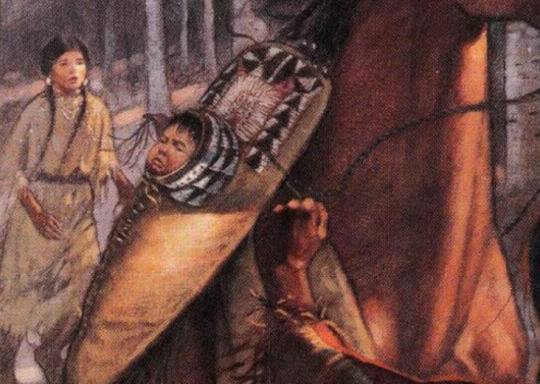
Kaya’s baby cousin, the daughter of Running Alone. She is saved by Swan Circling at the beginning of Kaya’s Hero.
Okay, so light is “Hawkáuit.”
The on preposition is already contained in many verbs and expressed by the removal of the –zese in the root of verbs. So first we need a verb for the light being on the water. To sit on is “Ueksilikézese,” and to fall upon in drops is “Isiséulizése.” So whether her name has Ueksilik or Isiséuli depends on whether her name is light sitting upon the water or light falling upon the water.
Water specifically is “Kus.” Considering her name isn’t “light on the river” or “ocean” or whatever, “Kus” is probably correct.
Little Branch
Rushing Brook’s infant daughter, from The Roar of the Falls.
Little is “Kúzkuz.”
Branch would be “Pátoi.”
Little Fawn

A girl in Kaya’s village. In Kaya’s Hero she is hurt jumping out of a tree, and she’s often noted to play Shinny with Kaya.
Little is “Kúzkuz.”
According to nimipuutimt.org, a general term for a fawn would be “tatx.”
Lone Dog

The lone wolf that Kaya helps and the mother of Tatlo.
Lone as an adjective is used by putting -zuàtg at the end of the personal pronoun. Ipzuàtg is “they (singular) lone,” but I think we can just add it at the end of the word “dog”? I may be wrong tho.
A normal dog is a “Zikámkal.” There are two names for wolf meanwhile; “Izeyéi” is small and “Ímiin” is large. I’d say lone dog’s name is likely Zikámkal, as she seems to be less of a wolf and more of a dog if you know what I mean.
So her name could potentially be Zikámkalzuàtg.
Magpie
Kaya’s despised nickname.
This one is very simple: Ékeg.
Many Deer
A temperamental man in Kaya’s village.
Many is “Illégi” as an adjective. As a pronoun for persons only, it’s “Illegniue.”
Now we get to talk about the words for male deer yay!! Once again, Ímes is for the general word. The male red deer is Téuisin, reindeer is Tipitéuisin, elk is Ueúkie, and moose deer is Sákslas.
Rabbit
A daring girl in Kaya’s village a little older than her.
Another simple one: rabbit is Éyukz.
Raven
Kaya’s older cousin who lives in her village.
Raven is Kókog.
Red Duck
Kaya’s aunt in her village.
For red: bright red / vermilion would be “Hilpilp”, while a deep red / crimson would be “Lemtlémt.”
A wild duck would be “Kétket.” A tame duck would be “Éutet.”
Red Stone
Tall Branch’s relative.
For red: bright red / vermilion would be “Hilpilp”, while a deep red / crimson would be “Lemtlémt.”
There are a couple words for stone colors but haven’t found one for red, only yellow, white and black. So the normal word for stone is “Pisue.”
Runner
Kaya’s father’s horse.
Ulekeiktípez.
Running Alone

Kaya’s young aunt, mother of Light on the Water.
We got a couple words for “run.”
To move swiftly: “Ulékeikse.”
To make [another] run: “Seulekéikse”
To run suddenly: “Tekekéikse”
To run to help somebody: “Tekékeikezése”
To run in a race: “Uléluikize”
To run after someone else: “Tiuekikze”
Alone, meanwhile, is “Inzuáty” as a noun. As an adjective, it is used by putting -zuàtg at the end of the personal pronoun. Ipzuàtg is “they (singular) lone,” with “Inzuátg” as I lone and “Imzuátg” as you lone.
Runs Home
A young man in Kaya’s village, the one who taught Two Hawks to make and play the flute.
We got a couple words for “run.”
To move swiftly: “Ulékeikse.”
To make [another] run: “Seulekéikse”
To run suddenly: “Tekekéikse”
To run to help somebody: “Tekékeikezése”
To run in a race: “Uléluikize”
To run after someone else: “Tiuekikze”
Home is “Init.”
Rushing Brook
A young mother in Kaya’s village.
"Rushing” is a bit hard to find. Looking at different versions of flow, though,
“Uéleze” is basic flowing,
“Uelétze” is to come out flowing,
“Tekeuéleze” is to flow suddenly/falling down,
“Uelikze” is to rise flowing.
As with other words, fast as an adjective is “Ámtiz,” and I’ve already copy-pasted the words for run up above.
A small stream (brook) would be “Póol.”
Snow Paws
A dog in Kaya’s village.
Snow as a noun is “Méke.” Paw would be “Kípzuz.”
Sparks Flying

Kaya’s horse’s colt, named for the fire he, his mother and Kaya escaped.
“Sparks” is a bit hard to figure out.
The noun for fire is “Álliksa” or “Álla”, but I don’t think it would just be fire, but specifically the sparks.
“Líuze” (to burn with rising, steaming fire) or “Ilepílikse” (to burn as when a flame breaks forth) could work, though it is a verb and Sparks is a noun here...
Another verb/adjective instead of a noun, but glitter as a verb would be “Ilapáiksa” or “Ilapáikin” as an adjective.
Verb for sparkle is “Itgolizása”, adjective sparkling is “Pítgolzatipaz.” I wasn’t able to find a word just for a Spark.
We got a couple options for “fly” too:
To fly: “Ueikze”
To fly about: “Ueinikse”
To go about flying: “Ueikéikse”
To fly upward, as on a tree: “Ueletiekse”
To fly upward, to soar / float: “Iyalásasa”
To flee, run away: “Ulelikze”
I think the most likely in context for Sparks Flying would be “Ueinikse” (fly about) or “Ulelikze” (flee). Also to note: the nouns for flight are “Ulelikin” for running away and “Ueíkin” for soaring.
Sparrow
One of Kaya’s twin brothers.
Uekiukíun.
Speaking Rain
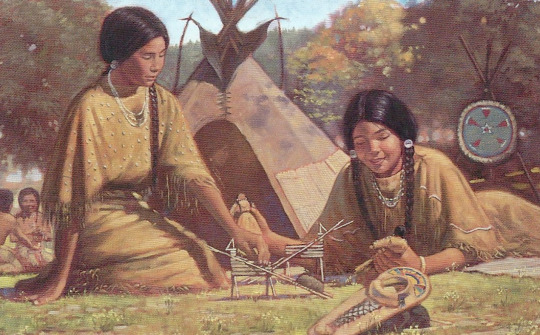
Kaya’s beloved sister; she is biologically her second cousin, but was adopted by Kaya’s immediate family after her parents’ death.
So, there are a lot of words to be used for “speaking.” These are the most likely for her name:
“Tennése”: direct translation of “speak.” If her name means “rain that talks,” this is probably the word.
“Pitenuése”: to speak mutually. If her name means “rain talking amongst themselves”, this is the word. [”Pitáutennése” is also this word for specifically speaking at night.]
“Ueuise”: to begin speaking.
“Uainakasa”: to cease speaking.
The second part of her name is much easier: Uéket means “rain!”
Squirrel
A young boy in Kaya’s village, mentioned in The Roar of the Falls.
Zilmii.
Steps High
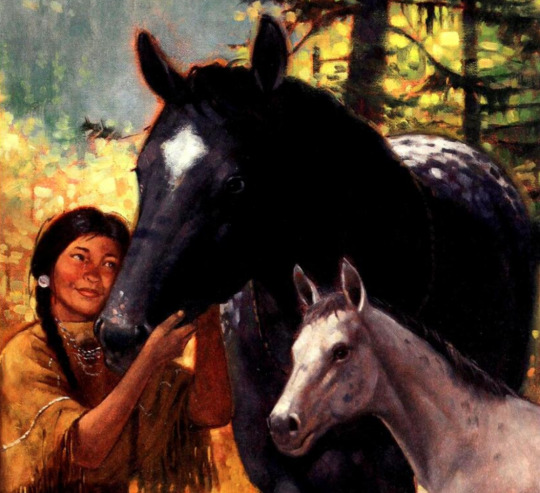
Kaya’s beloved horse.
If we assume that the steps is a verb, the first word is either “Uetikise” (to advance) or “Uatikzása” (to set the foot upon). [Noun would be “Uetikt”]
Now there’s a couple words for “high” as well. “Tústi” means being in elevated place. “Kuhét” means of a tall statue.
Swan Circling
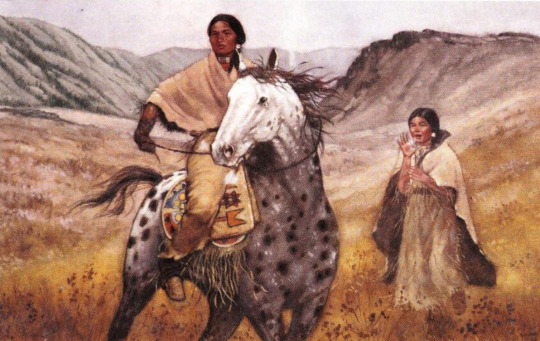
Kaya’s hero; this will also be Kaya’s name as an adult.
A swan is “Tákaisin.”
Circling, meanwhile? Difficult, but I believe it’s “Temepéise,” which is to encircle.
Tall Branch
Kaya’s maternal aunt.
With tall, we have to wonder if this would be referring to actual height, or simply length; the good news is, the first word we have can mean both “tall” and “long!” Our options are “Kuhét” or “Imékes”; Kuhét is used for more slender items, with Imékes for large-framed.
Branch would be “Pátoi.”
To Soar Like an Eagle
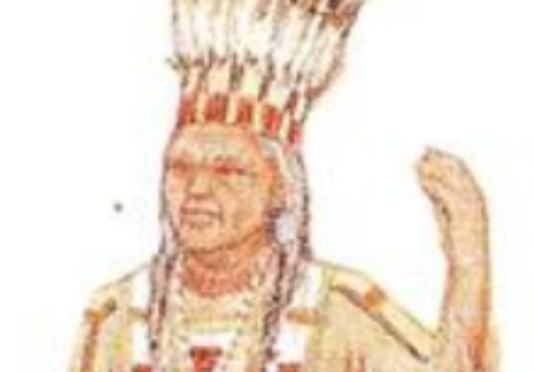
Kaya’s village chief.
As stated with Sparks Flying, to soar is “Iyalásasa.”
Like as in denoting similarity is to add –uàkos to the end of the noun.
As for eagle, a bald eagle is “Sakantáig,” and other fully-red eagles are “Kaspaaláya.” So either Sakantáiguàkos or Kaspaaláyauàkos.
Two Crows
Tall Branch’s relative.
Two is “Lepit.” “Lepú” is used as a pronoun for persons only.
A crow is “Áa”, though a jackdaw or blackbird would be “Kuóskuós.”
So it’s likely Lepit Áa.
Wing Feather
One of Kaya’s twin brothers.
Large/Quill feathers are “Uéptes,” and Down/Small feathers are “Kótkot.” I believe Wing Feather’s name would thus be Kótkot but I do not know a ton about birds.
Yellow Flower
A young mother in Kaya’s village.
Yellow as an adjective is “Maksmáks,” (maqsmáqs) though yellowish would be “Keugkéug.”
A flower is “Látis.”
Another thing to note: specifically “the flower becomes yellow” is translated as “Látis imkasiza,” so this could be her name as well.
Yellow Sky
An elderly storyteller in Kaya’s village.
Yellow as an adjective is “Maksmáks,” (maqsmáqs) though yellowish would be “Keugkéug.”
Sky is a word that depends on whether it is cloudy or clear. Cloudy sky is “Ipelikt,” while a clear sky is “Aikát.”
BONUS: Non-Nimiipuu Characters
Gift from the Stick People
The Nimiipuu name given to Hawk Rising’s baby after Crane Song found her.
A gift would be “Ínit.” (though “Pinit” would be a mutual gift, which I believe means a traded item? I think Ínit would be most appropriate here.)
Now, from is used in this language by the suffix “-kínig.” (IE: from Kaya would be Kaya-kínig).
The Stick People are dwarves in several Indigenous-American traditions, including both the Nimiipuu and the Arapho. The Nimiipuu called them the Its’te-ya-ha, and said that they lived in the deep woods and had the power to make themselves invisible and become incredibly strong.
So Hawk Rising’s baby would be named Ínit + Its’te-ya-ha-kínig.
Hawk Rising
Kaya names the Silent Stranger “Hawk Woman” after she sees her watching a hawk on a cliffside. At the end of the book, she establishes to Kaya that her name is actually “Hawk Rising.”
So Kaya’s name for her:
A hawk that’s often seen in poultry yards: “Pitámianun”
Goshawk: ironically, “Káya”
These were also listed as “various kinds of hawks,” with no specifics. Hopefully I can find specifics later: “Íkeg, Talauyágoz, Káyauákos, Leplépuékos.”
Woman would be “Háyat.” Rising would be...
To come out, as the sun: “Tilétze”
To go up, as the sun: “Tilása”
To come out on a sudden: “Tekétilètze”
To rise from death or unconsciousness: “Utelétze”
To rise, as fog: “Ipalásasa”
To cause to rise (such as standing up and scattering dust): “Tulékoksa”
I feel like the most likely here would be Tilása or Tekétilêtze. However, considering her backstory of escaping a deadly fire, thematically Utelétze would work incredibly well.
But let’s find out what tribe she’s from to find her real name.
From the first chapter of The Silent Stranger:
“Her hair is in one thick braid instead of two, like ours, and the backs of her hands are tattooed.”
“What’s she wearing?” Speaking Rain asked, giving Kaya a nudge.
“Under her bearskin she’s got a cape of woven bark with fur at the throat,” Kaya said. “She’s wearing a necklace of dentalium shells, and abalone ear ornaments, too. She looks like the women who live on the seacoast and come to the Big River to trade.”
Here is her backstory, from pg 99-100:
[...] warriors from up the coast had raided her village. She was taken captive and made a slave. Her captors took her with them to the Big River. There, a man from over the high mountains saw her and made her his wife. He was a good man. She went with him and lived with his people. She was traveling with her husband when a storm stranded them[....]
We also have this description of her baby’s tee-kas:
“[The baby’s] tee-kas is part of my story. It’s not made like ours. It’s made of cedar, with cedar-bark cloth for a wrapping. Women from the coast make their tee-kas like that, and the baby has a pretty necklace of dentalium shells. Why her unfortunate parents were traveling in Nimíipuu country is a mystery, but she’s safe now in Crane Song’s care.” - pg 109
The coast tribes by the Northwest would be Tlingit, Haida, Tsimshian, Kwakiutl, Bella Coola, Nuu-chah-nulth, Coast Salish, and Chinook.
So we gotta find which traded with the Nimiipuu at the Big River. Because there are so many tribes, I could be wrong, but I think it is likely that she is from the Coast Salish; they were known to use cedar bark for weaving many things, including tee-kas. [1, 2] They would have had access to dentalium shells as well, and the very real historical connections between the Nimiipuu and Salish were already established in the mainline series.
Other possibilities include the Haida and Tsminshian, who are noted to have had abalone access, and the Nuu-chah-nulth, who not only would have had access to abalone but were the primary harvesters of dentalium. They were known to dress their high-status unmarried girls in dentalium shell necklaces. While that wouldn’t apply to Hawk Rising, it could apply to her daughter.
There are many, many different dialects of the Salish language, but looking at this map, I think it’s likely that in order to be near Nimiipuu territory, Hawk Rising would be in the Lushootseed or Cowlitz/Chehalis areas.
We have two options for “Hawk” from the Lushootseed dialect, actually.
Fish Hawk: c̓ix̌c̓ix̌
Redtail Hawk: x̌ibx̌ib
The similar dialect Twulshootseed also uses “x̌ibx̌ib” to mean hawk; I can’t find info on whether or not they use “c̓ix̌c̓ix̌” as well. I will say that I think x̌ibx̌ib is probably more likely.
As for the word for “Rising” or the Cowlitz translation, this is where I kinda. Cannot continue currently. I have not been able to find a dictionary for the Cowlitz. However, when I have the ability I would love to ask native-languages.org once again. If anyone else would like to do so, or take part in their fundraiser, here is a link.
Otter Woman
A woman from “Enemy Country” that held Kaya and Speaking Rain as slaves. “Otter Woman” is only what Kaya calls her, and thus we don’t know her actual name.
First: Kaya’s name for her. Otter is “Tulúlg.” Woman is “Háyat,” with an elderly woman being “Hátuai.”
But onto figuring out her potential tribe, just for fun. From Chapter One of Kaya’s Escape:
She thought they spoke the language of enemies from Buffalo Country[...] they had driven the herd all the way through Nimíipuu country to the northern trail through the Bitterroot Mountains.
Chapter Two also says they go over the Buffalo Trail, and Kaya spots the Lochsa River as they pass. As the Lochsa River is to the west of the Bitterroot Mountains, that means the enemies are traveling west and live in that direction.
I am absolutely useless at Geography, but Google tells me that the Bitterroot Mountains border Idaho and Montana. So if they’re traveling west, that would most likely put them in the areas of Idaho, Washington, Oregon or even Canada, depending on how far their homeland was.
When moving to the Northwestern Plains to hunt buffalo, Wikipedia says that the Nimiipuu enemies there were the Blackfoot Confederacy (Piegan, Kainai, Siksika), Lakota, and Cheyenne.
Looking at a map of indigenous land, directly west of the Nimiipuu were Coeur D’Alene/Skitswish, Yakima, and Walla Walla. If her tribe were in what is now Montana to hunt Buffalo at the time of Kaya’s Escape, they would be in Flathead Kutenai territory, perhaps even Blackfeet. They could also still be near the Skitswish or Okanagan.
Spotted Owl
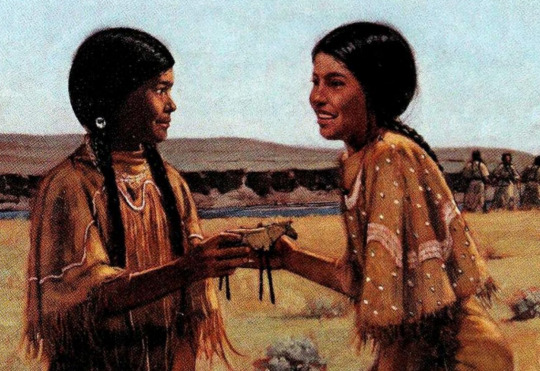
Kaya’s Wishram trading partner, from Kaya and the River Girl.
Spotted Owl is a Wishram girl, so she would be speaking Upper Chinook. Using washington.edu’s abridged Chinook dictionary, Spotted would be le kye or tzum, depending on how it’s spotted: calico is tzum and piebald is le kye. I’m not sure which one would refer to the actual spotted owl, perhaps calico?
Owl was a bit harder to find; the anthrosource online library does have a Chinook dictionary that I poured through, and I believe owl may be “qoēl.”
So her name could be le kye + qoēl.
If translated to Nimiipuu: an owl would be “Saglatáma,” while a small owl would be “Púgpukélez.” Spotted would be “Kaskás”; while it specifically refers to dapple-gray pattern, it is used for most spotted things.
Two Hawks
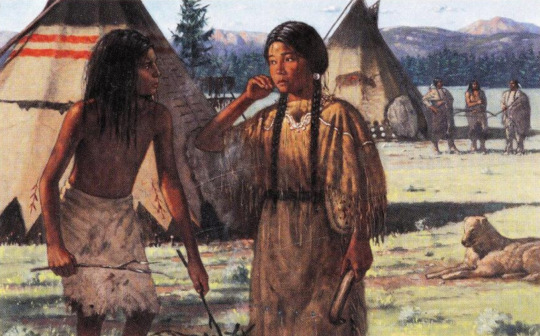
I have a full post here, where I contacted Laura Redish of the Native Languages of the Americas to ask about his name. Here is what she said:
The Salish word for two is “esel.”
A fish hawk/osprey would be c'ixʷc'xʷ.
A red-tailed hawk would be a c'lc'lšmu.
A sparrow hawk/falcon would be aatat.
“So this character's name could have been something like Esel C'ixʷc'xʷ, Esel C'lc'lšmu, or Esel Aatat.”
Considering what English-speakers mainly associate with hawks, I’d say “Esel C'ixʷc'xʷ” is probably the most likely.
Additional information: according to spokanelanguageculture, a redtail hawk could also be “Spya.”
White Braids

Speaking Rain’s Salish adoptive mother.
White Braids would, like Two Hawks, be using the Salish Spokane-Kalispel dialect, as they live in the same tribe.
White would be “piq,” pronounced like the English pick. I have not yet been able to find the specific word for braid– I have been able to find the sentence “they braided their hair.” (čyilya’xʷ qnm) I tried to go through the Kalispel-English dictionary I could find online but could not find “braid”– if anyone else wants to try, the links are here and here. I will also try to ask native-languages.org when I have the ability.
Sources: spokanelanguageculture
Young Uncle
Two Hawks’s maternal uncle. “Young Uncle” probably isn’t his name but it’s the best we have to go on.
A maternal uncle would be “ssiʔ.” Young as a descriptor would be “sk̓ʷu̓k̓ʷiml̓t.”
Dictionary
Morvillo, Anthony. A dictionary of the Numípu or Nez Perce language. , https://doi.org/10.5479/sil.1076821.39088005784111
#american girl#kaya'aton'my#nez perce#nimiipuu#american girl dolls#american girls#beforever#1764#speaking rain#two hawks#native languages#nimiipuutimt#nimiiputímt#mine
49 notes
·
View notes
Text

Native American Nez Perce 1910s 1912 ... Iprelilict-Illam-Ke-Wat (Pile of Clouds), Nez Percé, in Partial Native Dress with Ornaments and Holding Flute - Gill - JAN 1912
Courtesy of Native Sioux ...
106 notes
·
View notes
Text
On This Day In History
June 17th, 1877: The Nimíipuu (Nez Perce), an indigenous group in the Pacific Northwest, defeat the U.S. Cavalry at the Battle of White Bird Canyon.
June 17th, 1960: The Nimíipuu (Nez Perce) is awarded $4 million for an undervalue of land from the 1863 'Thief Treaty'.
#history#indigenous history#coloniation#nez perce#Nimíipuu#american indian wars#battle of white bird canyon#miniipuu
62 notes
·
View notes
Text
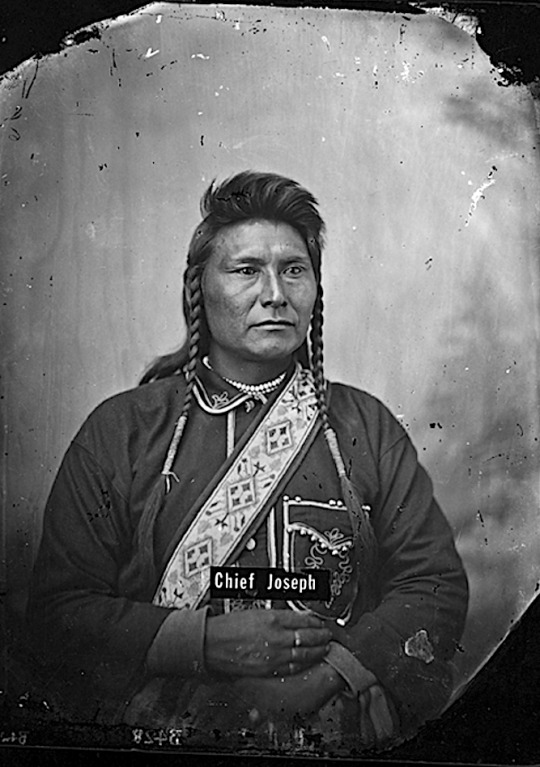
Chief Joseph taken a few weeks after his surrender in 1877, Nez Percé - Goff - 1877
38 notes
·
View notes
Text
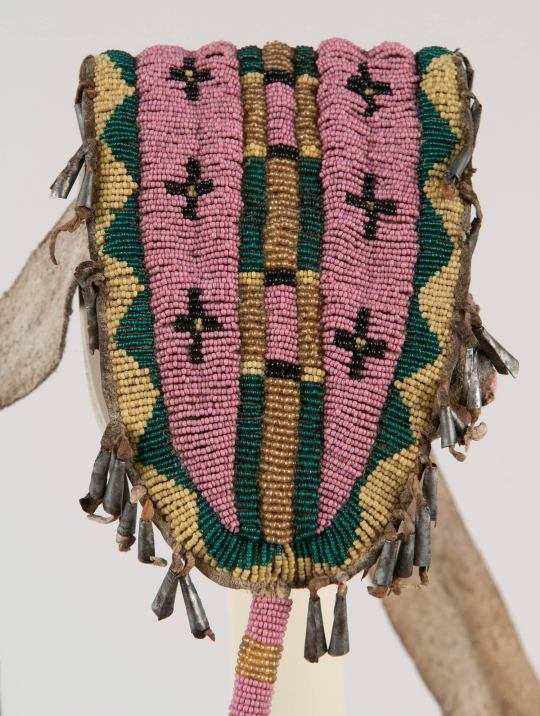
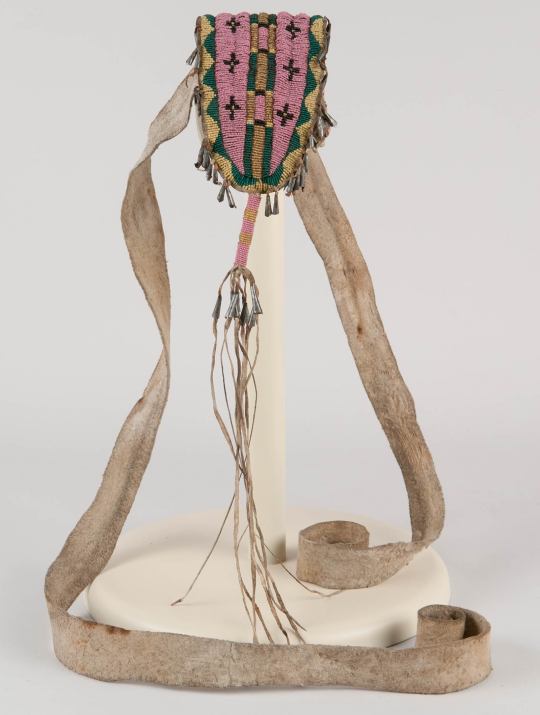
Belt Pouch
cúuyesıtkeˀs
Nez Perce (attributed)
ca. 1860 – 1870
Interpretive text from Nimiipuu Tribal Committee:
"Hip bags or side purses were worn by both men and women, and became a functional item of everyday dress for many of our people. Oftentimes, in certain formal occasions, these bags would be worn on the belt, in the back by the women. This particular bag may not be from the Nimiipuu and may have originally been constructed much later than most of the items represented in this collection."
Bison hide, tin, glass beads, sinew. H 11, W 8.5 cm
Nez Perce National Historical Park, NEPE 8753
#Native American#beading#bead work#Native American arts#culture#Nez Perce#art#folkart#Hip Bag or Purse
22 notes
·
View notes
Text
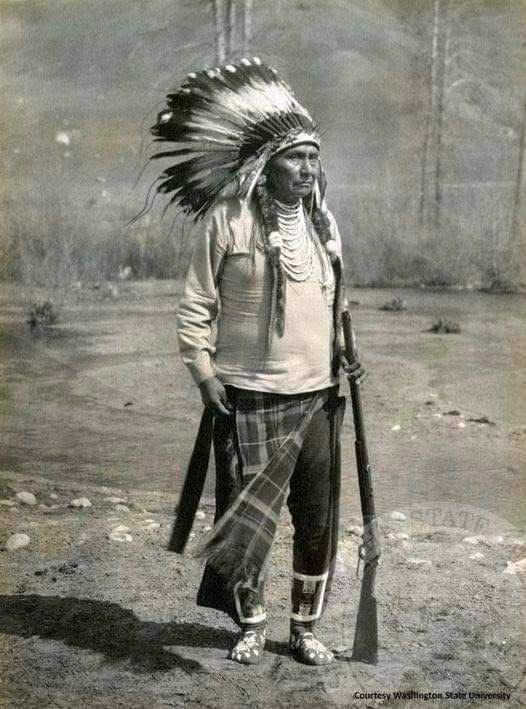
We live, we die, and like the grass and trees, renew ourselves from the soft earth of the grave. Stones crumble and decay, faiths grow old and they are forgotten, but new beliefs are born. The faith of the villages is dust now... but it will grow again... like the trees.
~ Chief Joseph, Hin-mah-too-yah-lat-kekt, (3 Mar 1840 - 21 Sept 1904) Chief Joseph was the leader of the Wal-lam-wat-kain band of Nez Perce who were forcibly removed from their ancestral lands in the Wallowa Valley (Oregon). Photo by Edward H. Latham (28 May 1903)
relatives!
[Native Lives Matter]
28 notes
·
View notes
Text

#indigenous#chief joseph#nez perce#native american#nimiipuu#indigenous americans#20th century#Colville#Nespelem#history#photographs#historical photos#Hin-mah-too-yah-lat-kekt#nez perce art.
12 notes
·
View notes
Photo

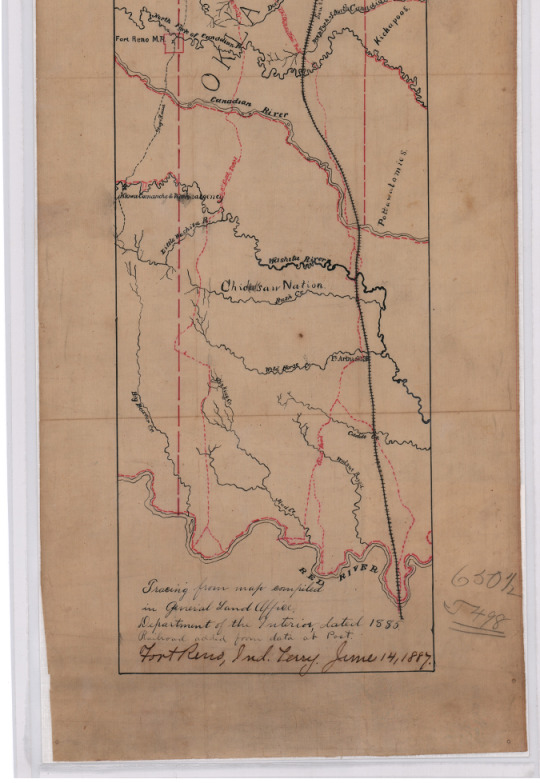
Map of part of Indian Territory and the State of Kansas, 6/14/1887.
The area in the center of the map was opened to white settlers two years later, and would become Oklahoma City.
Series: Central Map File, 1824 - 1960
Record Group 75: Records of the Bureau of Indian Affairs, 1793 - 1999
Image description: [top half of map] Map covering Oklahoma from north to south borders, and about wide enough to cover modern Oklahoma City. The map shows streams, railroads, smaller towns, Fort Reno, and locations of the lands of various Native American tribes, including the Nez Perce, Ponca, “Otoes and Missouras,” Iowas, Kickapoos, Pottawatomies, and the Chickasaw Nation.
Image description: [bottom half of map] Map covering Oklahoma from north to south borders, and about wide enough to cover modern Oklahoma City. The map shows streams, railroads, smaller towns, Fort Reno, and locations of the lands of various Native American tribes, including the Nez Perce, Ponca, “Otoes and Missouras,” Iowas, Kickapoos, Pottawatomies, and the Chickasaw Nation.
#archivesgov#June 14#1887#1800s#maps#maps and charts#Oklahoma#Indian Territory#Kansas#Native American history#American Indian history#Indigenous American history#Nez Perce#Ponca#Otoe-Missouria Tribe#Iowa#Kickapoo#Potawatomi#Chickasaw
45 notes
·
View notes
Photo

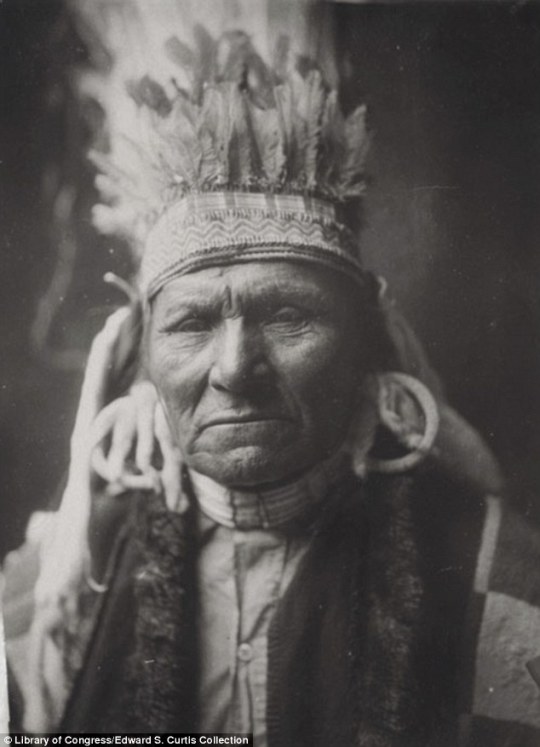
Nez Perce
The Nez Percé are an Indigenous people of the Plateau who are presumed to have lived on the Columbia River Plateau in the Pacific Northwest region for at least 11,500 years.
Members of the Sahaptin language group, the Nimíipuu were the dominant people of the Columbia Plateau for much of that time, especially after acquiring the horses that led them to breed the appaloosa horse in the 18th century.
https://en.wikipedia.org/wiki/Nez_Perce
10 notes
·
View notes